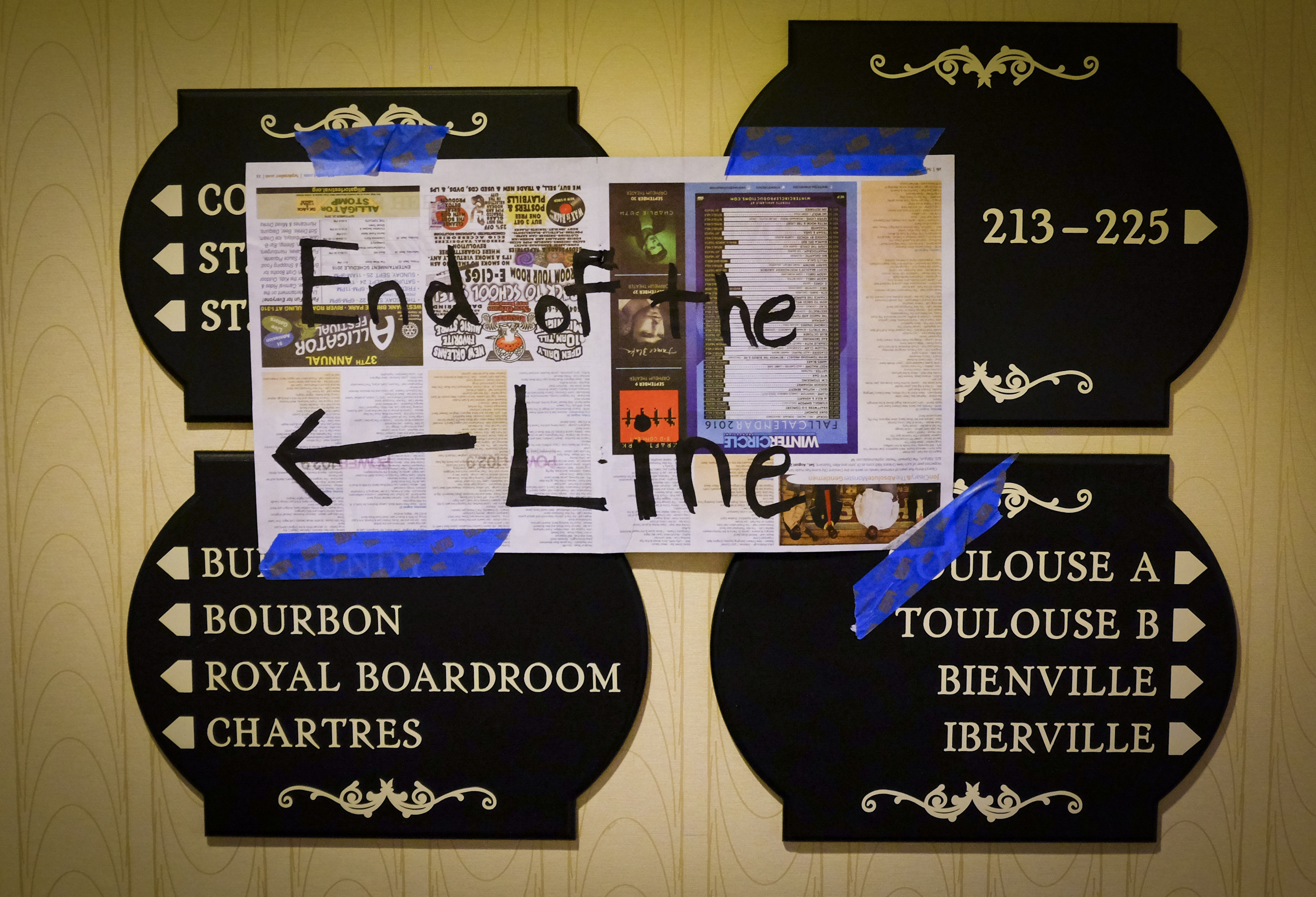This is the second in a series of posts about the safety and calibration systems used in the New Orleans run of the larp End of the Line. Today’s mechanic is so obvious that I would assume it’s been “invented” independently in a bunch of larp communities, although I’m relatively certain I hadn’t come across it before I introduced it in my calibration design for Inside Hamlet. I’d be happy to hear about other larps and traditions where you’ve used it, or other variants of it, whether for this exact purpose or something different! (I’m not entirely sure where I picked the concept up myself, but I would assume it was from pro wrestling).
The tap-out is a mechanic for players to communicate to each other about their limits.
Basic Procedure
- To perform a tap-out, you tap your co-player’s arm or another convenient part of their body twice, and repeat this action as many times and as hard as you need to get their attention. (Typically, once and quite softly is enough).
- Everyone stops what they’re doing. If you are holding someone, you release them; if you are screaming, you take a break from screaming; if you are blocking someone’s path, you make sure they are free to go, and so on. Please note that not all situations have an “active” or a “passive” party, and even when they do, the active party is as free to tap out as the passive party.
- In this tiny break, the person who tapped out can choose to either stay or go.
- If they need to go, they are allowed to go, no questions asked. In the larps I’m involved with, usually this means both the player and the character leaves the situation. (See farther below for some examples of how this works). Depending on your larp, you might want to add some player care here, but be cautious. Since the problem is created by the specific situation, it is much better to have a staffed space, like an off game room, where the player can retreat, instead of forcing them to interact more with those specific players at that specific moment.
- If they stay, it means they’d like to continue the scene, but with just a little less of whatever was going on. Less screaming, less sexuality, less restriction of movement… Everyone dials it down a bit, and play continues, no OOC language required. (Unless it is required, in which case you speak, but see below).
- When someone taps out, you do not ask them why, and they should not tell you why. This is to protect both of you and all the other players. Maybe they tapped out because you have terrible breath – do you really want to have a conversation about that right then? Maybe they tapped out because the dialogue suddenly reminded them about a horribly dysfunctional or traumatic situation in their past. Maybe they tapped out because it’s the middle of the night and they already went to bed once and now they’re not wearing a bra and feel weird about it – it’s none of your business. And it’s not about you.
- Not talking about why has a double function. It avoids the creation of a hierarchy of differently valid reasons for self-care. It also creates protection for people who tap out for very private reasons. To put it bluntly: if you’re only allowed to tap out because of rape trauma, no one will tap out, because they may not want to share that experience. So you need to be able to tap out at any time when something in the situation is making role-playing too difficult, or even impossible.
- HOWEVER – the player who taps out may offer suggestions on playstyle as long as they don’t say why they have that preference. For instance, “can we continue but without you blocking me in physically? The screaming is fine, you can scream more if you’d like”.
Additional Rules & Requirements

That’s the basic procedure. There are some additional rules and requirements needed for this to work.
- It is almost always necessary to combine the tap-out with other mechanics. A baseline tool that all larps should have in my opinion is a word that signals “I need to say something out of character”. This word in my play culture is “off game” (please remember that new larpers need to be taught this). In my play culture we usually have a pretty absolute embargo on talking about your character off game in the play area during run-time, but we still need the word, to be able to for instance communicate real-world emergencies. It also operates as a good backup for tapout in the dark, or if a player panics and can’t remember what to do.
- If you can’t reach your co-player, or if it’s a multi-player situation, you can tap yourself twice on the chest instead. This still requires a line of sight though and may not work at all larps, for instance if it’s dark or many people interact in confused situations. In a game like that, you need at the very least a safe word (which can be “off game”). At our New Orleans run of End of the Line, we used the Lookdown technique as a parallel to tap-out for when you’re not in reach. It also adds some other features, which I will cover in my next blog post.
- For tap-out to work, all players must have at least one hand free at all times. This should be in your rules. It is also not good safety design to actually tie people up – you can pretend tie them up.
- Remember not all players have the same number of hands or the same mobility, so tap-out may not be an appropriate mechanic for all larps. If only a small number of players are unable to use it, however, you can offer the a verbal cue as a parallel method – for instance “Off game – TAP OUT”. Remember to workshop (=practice) this with all the players. You don’t need to be all ableist about it, if the game area becomes dark or confused, it’s a useful backup for everyone to have mastered.
- You can’t tap out of something that has already happened. If tapping out is at the core of your safety design, it must be combined with some level of “no surprises” culture. Not jumping people, not grabbing them from behind… What it works really well with is slow escalation and telegraphing your intent clearly. This is sometimes called bullet-time consent. Basically, you play certain types of actions – like violent or sensual – in slow motion, allowing the other player to make active choices about how to position themselves, how to react, and whether to tap out.
If your players are comfortable with this type of play, they may not even need a verbal negotiation system on top of it. (As long as you have a word like “off game” to be able to sort out confusion if it occurs). In Inside Hamlet, bullet-time consent was pretty much it. At End of the Line in New Orleans, where most players were new both to naturalistic-looking simulations of violence and intimacy, and to consent mechanics in general, we combined tap-out with a VERY detailed verbal consent negotiation mechanic. It worked beautifully!
Player Experiences and Character Outcomes

Please note this technique is about the player’s limits – it does not determine what happens inside the fiction. In the Nordic tradition, where we often put a premium on minimising out of character action in the play area during run time, and our larps do not always have plots in the traditional sense, the elegant solution is to align the rules of the fiction with the OOC mechanics.
For Inside Hamlet, for instance, we decided that in this court larp, where alienation and boredom were important themes, there is an in-fiction culture where it is always OK to tire of a situation and leave. Even if Claudius himself is speaking to you, you can just walk off. If you tap out and walk off, you co-players will make some sense of it and move on. Maybe your character is so defeated by the situation they can’t even handle it, and just drift off. Maybe your character is so fashionable they get bored mid-sentence talking to ordinary mortals and just leave. That’s just the way people behave at Elsinore. In a fantasy larp, maybe you can always go to the holy grove. In a scifi larp, maybe there is something wrong with teleporters. Maybe all the characters are on a lot of pretend drugs and find it difficult to concentrate from one second to the next, allowing their prey to run off.
There are obviously many larps where a plot train that has started can never stop. With tap-out as with many other calibration mechanics you’ll need to combine it with some rules for what to do if one player wants out and the scene still needs a conclusion. The simplest fix for this is a procedure whereby the well-being of both players is first attended to, and then the outcome of the scene is verbally agreed upon.

In a collaborative style larp, players would typically just negotiate that themselves; in many other larps it would make sense to summon a GM or storyteller at that moment. If the stakes are high (for instance, if the plot of many other players would be affected by how this robbery or seduction or negotiation concludes) a very simple story outcome resolution mechanic could be introduced into the larp. If you already have an abstract conflict resolution mechanic, there is no reason for the tap-out to overrule that. Who ever has the most points or rolls the die right wins the conflict; we’re just not going to play it out. Most of the time, this will work just fine.
I’m not going to state any hard and fast rules here. It’s not because I don’t have suggestions, I do, but you need to consider the specifics of your larp and your players. I can think of a thousand hypothetical scenarios for different types of larps and the answer for what a good system is would be different in each, and this is already getting quite long! (I’m happy to discuss specific situations with you, however! Ping me in the comments).
Fundamentally though? Well.
If your larp is physically intense, engages with potentially triggering topics, or involves realistically simulated aggression with players who are utter strangers, I might tap out because the other player just makes me feel unsafe (whether that’s in anyway connected to a real threat or not). In that situation I might want nothing to do with them, and be unwilling to stick around to resolve a conflict. But you know what? Players are more important than larps. If I’m too freaked out to engage, my well-being is objectively more important than my co-player’s story outcome. If I, having tapped out, go to the organisers for help at that time, a satisfactory solution can usually be found. And if I don’t trust the organisers enough to turn to them in a moment of crisis, then they might not deserve to finish that larp coherently anyway.
Most importantly: if you judge that your players are unwilling to try to negotiate fairly, or if you foresee a great number of situations where players are too afraid of each other to have a conversation out of character, there is no calibration system in the world that will make your larp safe. In that situation, your attention should be first directed towards designing the player culture – a topic I will return to many times on this blog!
Safety or Playstyle Calibration?

The tap-out is a safety mechanic, in the indirect sense of empowering participants to exercise self care and monitor their enjoyment and limits before they become too tired or overwhelmed to be attentive to their surroundings and co-players. It is also a safety mechanic in a rare, trivial but useful sense: at the Helsinki run of End of the Line, for instance, the dancefloor was very crowded and one player reported using tap-out when other players were dancing so intently they didn’t notice they were treading on her feet.
Fundamentally the tap-out is a calibration mechanic: it’s a tool for active player-to-player communication about playstyle intensity in a specific situation. It can fruitfully be combined with playstyle negotiation techniques of different kinds, but even there its purpose is to sort of say, “OK, that thing we agreed upon [whether explicitly or implicitly], having now experienced it so far, I now know this is where I do not wish to explore that further.” Or “Huh, I see that those words meant something different to you than to me, here’s my limit“. Or “Hey, I got really into this scene, and I think you did too, and I just realised I’m not going to be cool with it tomorrow if we continue so we better stop.” All of these are good reasons to calibrate play and really difficult to verbalise in an agitated state. That is why the tap-out is convenient and, dare I say it, elegant.

Reblogged this on Dragon Egg Inn and commented:
Thanks so much for doing this super necessary work & doing it so wel, Johanna Koljonen!!!
Support Johanna at https://www.patreon.com/johannakoljonen